-
Posts
332 -
Joined
-
Last visited
Content Type
Profiles
Forums
Store
Help Articles
Posts posted by JayBassin
-
-
What purpose does an acid like vinegar serve in the pie crust? My recipe (an old 1/2 butter 1/2 shortening one the my mother got out of Cook's Illustrated years and years ago) doesn't use it, and since I'm always fiddling around with the recipe, I'd be interested in experimenting with a little bit of acid.
A small amount of acid (vinegar, lemon juice, cream of tartar) in a wheat dough "shortens" the gluten--breaks the long strands. This makes the dough more tender and helps avoid the "toughness" caused by overworking wheat dough (which creates gluten strands). Pastry and cake flours have less protein, which means less gluten. Some flours (corn, rice, etc) have no gluten, which is a reason some recipes call for replacing some all purpose flour with rice, potato, or corn starches. Hope this helps.
-
I guess I work it similarly to jgarner53...........I pick it up frequently giving it turns, randomly so as I'm rolling out I'm keeping the round shape always.. I choose how I should roll the dough to keep it in a circular shape by thinning out the thickest area of dough along the way.
Being a self-taught baker (and Wendy, I know you are too), I don't understand the reasoning behind the turning of the dough. What is the purpose? In my mind, each turn is a risk that the dough will tear. No?
Di
I turn the dough also. I think a 1/8 turn or so each roll ensures that the dough isn't sticking to the counter, and ensures even pressure because you're rolling always in one direction. Not turning the dough means you're twisting your shoulders and rolling the pin sideways, which I find awkward and hard to roll evenly. My 2 cents.
-
I apologize if this has been covered before, but what is the difference between "arare" and "o-sembe" rice crackers?
-
I don't like to deep fry and my wife is firmly opposed to the extra fat. I make "tonkatsu" by coating a whole tenderloin (about 8-10 oz) and dredging in panko, then roast or "oven-fry" in an oiled pan, turning a few times. Kind of like oven-fried chicken. Works great if you're interested in lower fat cooking. After resting the meat, I slice into quarter to half-inch slices.
-
-----garde anger
This position is best apprenticed at Micky D's drive-through window
-
I'm pretty sure that absent garlic or fresh herbs, there's no vector for botulism, but that doesn't mean that it can't spoil in other ways. Jay, do you have a reference on that water issue? I'd love to see something definitive. Actually, I'd love to see a bunch of poeple saying "go ahead, no problem, we do it all the time!" DRColby told me he's kept tuna confit for a couple of months in the fridge, and that it was only poached in the oil for 10 minutes. He's very much alive, but I wish Ihad a few more warm bodies to reassure me.
I think Harold McGee's book discusses the need to remove all water from confit, or maybe James Peterson's "French Cooking". I found it to be the case by accident. It's the same with storing duck or goose fat: if it's rendered but not completely boiled so it's de-watered, it will spoil. Once all the water is out (you can tell because the bubbles change and the melted fat gets very clear), it will keep forever.
I've never heard that botulism comes from herbs and garlic. I think botulism can arise even in pure protein, like a bad can of tuna. Herbs and garlic, though, do contain lots of water that won't be rendered out during the confit process.
-
Yes, it will spoil. True confit works because the food is poached long enough to eliminate all the water. Bacteria require water to live. The covering of fat prevents water from being reabsorbed. I learned this (to my regret) after making confit of duck and being in a hurry. Your recipe doesn't cook the fish long enough (only 1/2 hour at a low temp) to eliminate all the water.
-
Does everyone use puff paste for sausage rolls? I've always used brioche dough or even a plain bread dough (like for pizza). I also like to add spices or herbs to the dough--my fav is tumeric because it gives a nice color and because I think it does something to provide a thiner crisper crust.
I agree also with Wendy about pre-cooking the sausage meat. I usually poach the sausage (double-wrapped in plastic) and then chill it with the dough before baking. Whenever I've tried raw sausage/filling, the grease made the dough pretty yukky and left gaps.
edited to correct spelling.
-
Any comments on making cream pies? I am looking for a speedier way to make the cream then standing over the stove and stirring for 1/2 an hour. Does it work to make it in the microwave? Also, any way to prevent the meringue from watering out or what ever is producing the running syrup in my pie?
Scroll up to my August 30 post on cream pie filling in this same thread.
-
Any thoughts on apple selection? Our old baker used to use red delicious - but I prefer a tart apple. Granny smith were my #1 choice - good tartness and they retain their shape. I haven't made an apple pie in a couple of years - but I'm thinking some of the new-to-me varieties may be good. Opinions?
I always like a mixture 2 or 3 of the the following apples: golden delicious, granny smith, empire, staymen-winesap. Haven't tried the heirloom apples that occassionally appear in the market. Fuji and gala are taking over most of the space in the market, and I think they're too sweet and too mushy for a good pie. Sometimes I add a pear or two to the apples---gives the pie a "mysterious" quality that people comment on. Finally, I rarely use cinnamon in the filling because it's so assertive--I mix the cinnamon with coarse sugar and sprinkle it on top of the crust. I prefer to use vanilla in the filling.
-
i want to make tandoori fish for a bbq party tomorrow. i know nothing about bbqing. will tandoori work on the grill?
To add to Waaza's reply, be sure to wipe off the tandoori marinade totally before putting the fish on the grill, and make sure the grill is very hot and very clean---otherwise the fish will stick.
-
2. The hardest step for me is getting the two crusts sealed together and achieving a good seal (this is after rolling). The crust is either too cold (from being put back in the fridge) or too warm. I use the above-mentioned crusts, roll on marble with a marble pin, the kitchen is 70-72 degrees and my hands are always cold. Also, are you using water to "glue" the crusts and what do you use to apply it (brush? fingers?). Cold water? Some other "glue"? Or does everyone have these problems?
I use a water seal. I just wet my finger, or if I have several pies, a pastry brush---and run it around. Then gently pinch the top and bottom crusts together.
3. Can someone show how to get a pretty crimp on a lattice pie? My lattices are very nice, but the crimped edge isn't. My latest method is to let the bottom crust be larger and bring it over the lattice edges. But still run into the too-cold too-hot problem.
Thanks!
With a regular top crust, most people roll or fold the top under the bottom crust, then crimp. With a lattice, it's best to fold the bottom up and over the ends of the lattice strips, but leave enough to flute.
-
I also think carbonnade is better than bouguinone. Here's a good recipe on the web from a Belgian source.
The difference between this (and other Belgian) recipes and the Joy of Cooking recipe is that the Belgians add thyme, lots more onion---always deeply carmelized---no garlic, and currant jelly instead of sugar. I've also seen recipes for mustard and pain d'epice (which I guess is close to gingerbread).
I carmelize the onions in butter for a long time and then take them out before I brown the beef. I always use a dark ale or porter.
-
I absolutely agree that (1) the demo is fantastic and (2) shortening only adds some flakiness, lots of trans-fats, and zero flavor. I think the reason shortening works is because it's pure fat---American butter is almost 20% water. I've used 1/2 butter and 1/2 clarified butter (be sure not to cook the clarified butter past the stage where all the water is boiled off).
I also make butter dough in a food processor and agree that it can get too mealy. I whiz 1/2 the butter in with the flour and let it get mealy, then add the other half of the butter in small dice and just blend. I add a teaspoon of distilled vinegar, which breaks gluten strands, and mix in ice water. I dump the rough dough on the counter and smear the chunky butter in with the heel of my hand, folding the dough together a couple of times.
I think that the diced and smeared butter provides the same flakiness as a shortening dough, with more flavor and no transfat. Admittedly, it's hard to do in large batches in a commercial kitchen.
-
The numbers were confirmed at 200. Their mistake not yours. Cheerfully pack up the leftovers for them or offer to deliver them to your local foodbank on behalf of the happy couple.
I agree fully with KatieLoeb: You can even get the foodbank to provide a receipt that you can price for the food, allowing the family to deduct the donation from their taxes. That will ease their pain at no cost to you.
-
...I did find that the very center of the bottom crust didn't seem to bake thoroughly, in spite of having a heated cookie sheet on the bottom rack of the oven, etc. per the directions. I was using a pottery pie plate, though, rather than Pyrex. Perhaps that had an effect.
I think using a pottery pie pan did have a difference---the thickness as well as the slower transfer of heat through the bottom. I use metal or pyrex pans for bottom-crust pies just for that reason. Rickster's suggestion of a pizza stone instead of a cookie sheet is a good one because a well-heated stone will provide more heat to the bottom. Be sure to pre-heat the oven and stone thoroughly (not just waiting until the oven temp clicks over).
-
-
well, yogurt doesnt have as much moisture as applesauce.
Also, doens sound like anything is wrong with the recipe. This sounds like an apple crisp. Since its only ten minutes baking time I hope your slicing your apples rather thin. This isnt like a pie that has apples pre-cooked over the stove in nice 1/4 inch slices. These slices should probably be the width of medium sized cardboard. This will decrease the cook time by a considerable amount. Also if you used an apple like red delicous its going to have a much different effect than an apple like a granny smith, or prety much any green apple.
A nice stiff green apple is what you want, incase you didnt use that.
I agree that there doesn't appear to be anything wrong with the recipe. Baking for a total of 45-50 minutes is about right. Chiantiglace must have overlooked the additional baking at a reduced temp. One Tbs of flour may be too little for a juicy apple, but ok for a Granny Smith if you didn't premix the sugar and let it stand too long. If you dumped the apple-sugar-flour-salt mix right into the crust just before topping and baking, and everything was dryish when it went into the oven, it's a mystery to me why you'd get several cups of liquid.
-
One of the biggest things I discovered even prior to reading this book is that the crust turns out way better if cooked on the bottom rack of the oven. This way I never have gooey, half-baked crusts. This may be common knowledge but it was new to me.
Another trick is to put a cookie sheet on the rack while preheating, and put the pie on the hot cookie sheet. Or, depending on the crust and whether you have a top crust, you can blind-bake the bottom crust and coat it with melted sugar (caramel), cooked cooled fruit gel, or chocolate.
-
It would help if you posted the recipe you followed. Only guessing here, but if you mix the fruit with the sugar too long in advance, the fruit will exude liquid. If you don't have enough starch to compensate, the filling would be too thin. However, I don't think you'd get "cups" of liquid. Do you add any liquid to the filling?
You might peruse the new thread HERE on pie fillings for further advice.
-
Here's my "all purpose" cream pie filling. It's written for lemon cream, but you can see the variations below. I try to bake low-fat whenever possible (not necessarily "low calorie." Consequently, I often use a nut-crumb crust instead of pastry.
Low-fat lemon cream pie filling:
Soften 1 tsp unflavored gelatin in juice of ½ lemon (about 3 Tbs) for 5 minutes. Don’t use the stuff in a green bottle—use water or your favorite liqueur if you don’t have fresh lemons. Warm for 20 sec in microwave until liquid and clear.
Beat together until smooth:
• 1 8 oz pkg neufchatel cheese (or non- or low-fat cream cheese) at room temperature
• ½ C non-fat sour cream
• 1 14 oz can non-fat sweetened condensed milk (not evaporated skim milk)
• ½ tsp almond extract
Beat in lemon juice/gelatin
Pour into a pre-baked pie or tart shell and top with sliced berries or other fruit*. Chill at least 2 hours.
*It is best to brush the completed tart (berries and all) with a glaze made from about 3 Tbs good-quality apricot preserves melted with about 1 Tbs cognac or kirshwasser, then pressed through a strainer. The glaze makes everything shiny and prevents the berries from drying out.
Variations
• Omit the lemon juice and put in ½ C key lime juice instead—key lime pie.
• Omit the lemon juice, add 1 tsp pure vanilla extract, use 1/3 C water + 1 Tbs instant coffee or espresso to dissolve the gelatin, and add 4 oz melted semi-sweet chocolate chips and top with walnut halves — chocolate mocha pie.
-
Fabulous demo. Pie crusts really scare me. I read about leaf lard in an old issue of CI and I must order some.
Im determined to make and enter a pie in our town fair. I just read an article about a deep dish apple pie( once again, i think it was CI) and they cooked the filling first. Anyone ever try that?
My demo for cherry pie (in the Demo: Press-In Crusts) thread uses pre-cooked (stove-top) pie filling. I think it's better for really juicy fillings like cherry. Not so important for apple. On the other hand, if I make an open-top pie (or tart or tart-tatin), I often pre-cook the fruit. Receipe for the cherry filling is on Recipe Gullet HERE.
-
This is a demo for making a cherry pie with a nut-crumb bottom crust lined with chocolate and a streusel topping. The techniques illustrate several things:
Making and forming a nut-crumb crust (same technique as making a cookie-crumb crust);
Making a streusel topping mixture;
Lining a bottom crust with melted chocolate; and
Cooking a fruit filling on the stovetop instead of in the pie, which ensures that the fruit filling is just goopy enough without being overly sweet and overly gummy.
Before going through this demo, click HERE to review and print out the master recipe I posted on RecipeGullet.
First make the streusel topping:
1. Mise-en-place for streusel topping (flour, sugars, slivered almond, soft butter, salt, flavorings)
> Put everything except the butter, almonds, and extracts into the food processor and pulse several times.
> Add the butter and extracts and blend away. Unlike a pastry crust, you don’t need to leave lumps of butter.
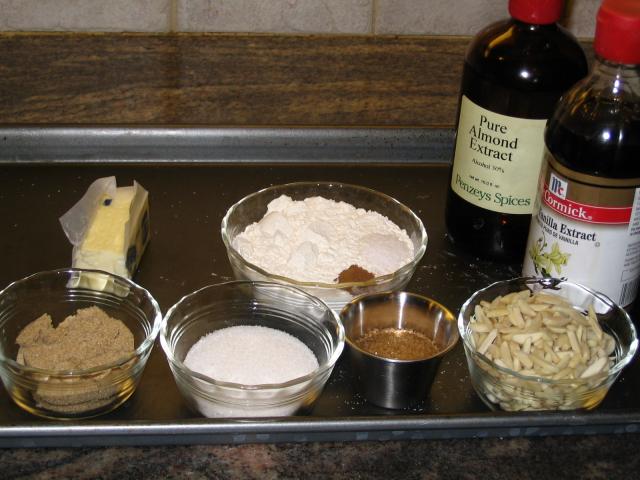
2. Interior of the food processor before whizzing the nuts. When the butter has disappeared, add the nuts. Pulse only a few times to chop up the slivered almonds, but not to make them into powder.
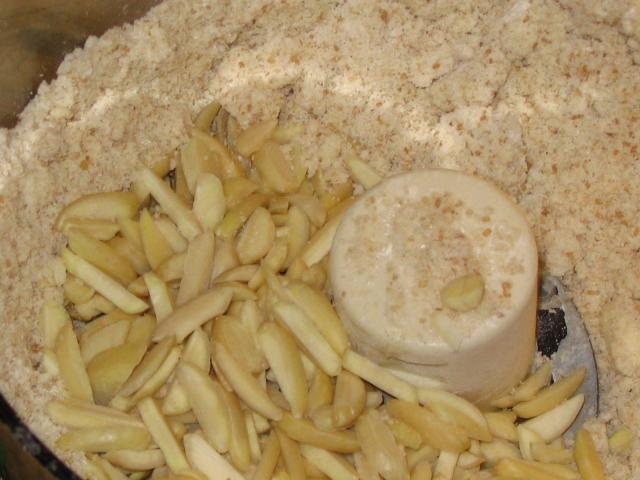
3. The finished streusel ready to chill. The lumps are the nuts.
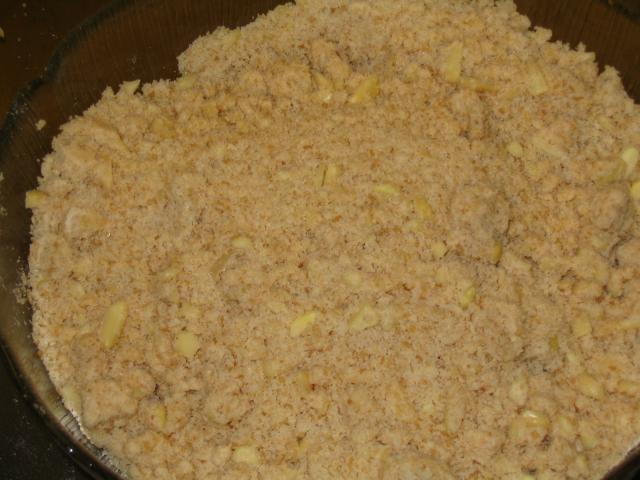
Next make the crumb crust (You don’t need to wash the food processor)
4. Mise-en-place for the nut crust (nuts, sugar, soft butter, salt, flavorings)

> Put everything except the butter and extracts into the food processor and keep pulsing until the nuts are finely ground. Don’t blend continuously or you’ll end up with nut butter. The sugars also help prevent making a nut butter. After the nuts are finely ground,
> Add the butter and extracts and blend away. Unlike a pastry crust, you don’t need to leave lumps of butter.
5. Interior of food processor when the crumbs are done
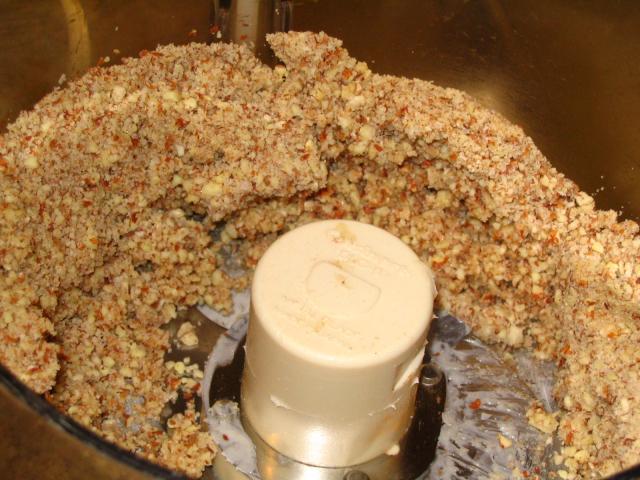
6. Crumbs dumped into pie pan.
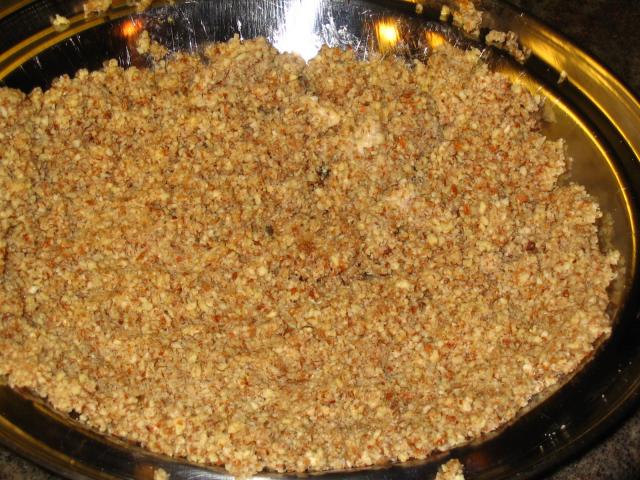
7. Use a custard cup (wrapped in plastic) for sides and press the sides and bottom firmly. If the nuts stick to the plastic, chill the pan and cup for 10 minutes.
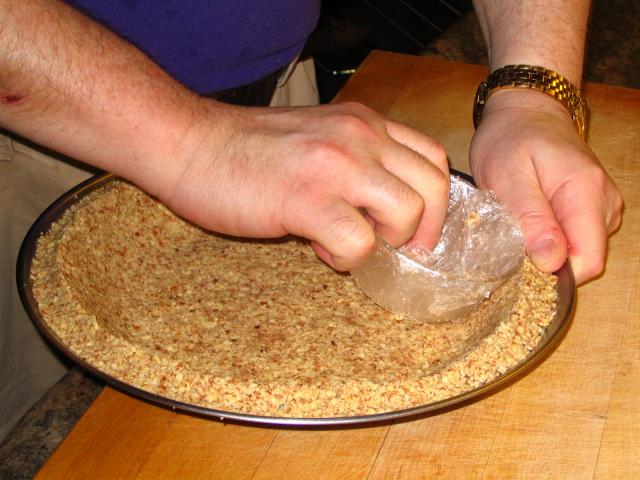
8. Crumb crust ready for oven (chilled)
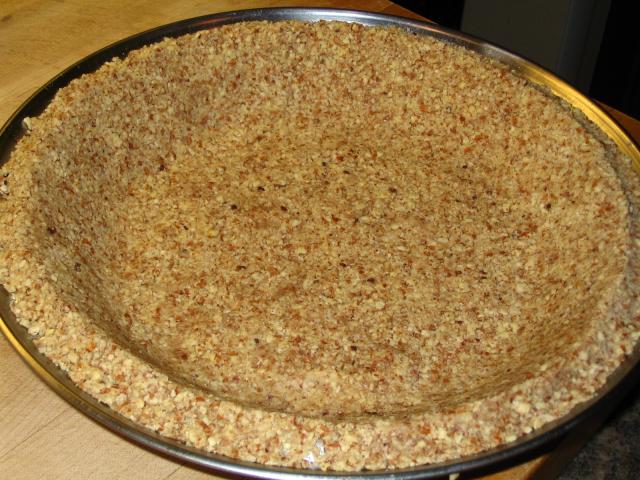
9. The baked crust. You don’t need to use pie weights on a nut crumb crust because there is no rising effect as with pastry.
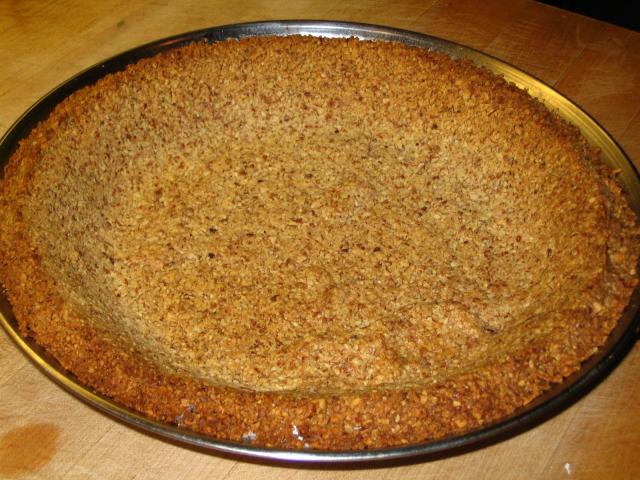
Coating the crust with chocolate:
10. The recipe describes melting the chocolate in a microwave. My trick for coating a baked shell with melted chocolate is to wrap the bottom from an 11” tart pan with plastic wrap, and with an offset spatula, smear the melted chocolate evenly on the plastic. Working quickly, flip the coated disk chocolate-side down onto the cooled shell, loosen the plastic, remove the disk, and allow the chocolate-coated plastic wrap to flop down and conform to the contours of the shell. Pat out any bubbles and chill. See the recipe for details. This picture (not very good) shows the wrapped metal disk coated with chocolate, ready to invert. The edges of the plastic wrap are folded under in this shot. You can barely make out the edges of the tin tart bottom.

11. Coated crust with plastic wrap showing, ready to chill until hard. The chocolate color looks weird, sorry.

12. Finished, chilled coated crust, ready to receive filling. While there are smears of chocolate on the edge of the pastry shell, they will be hidden by the streusel topping.
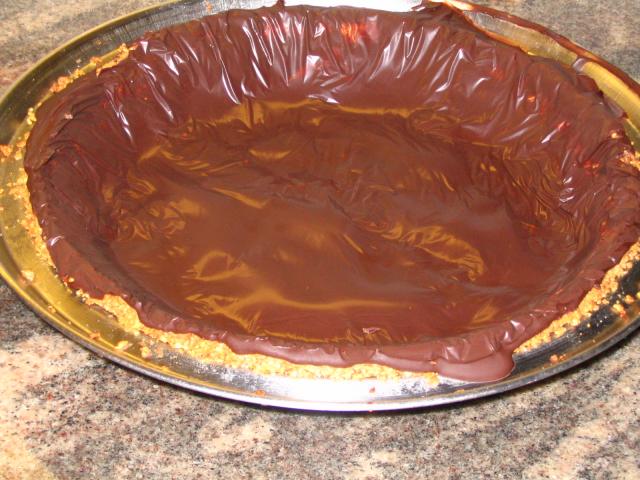
13. Pitting the cherries. If you don’t have a cherry/olive pitter, get one. This model only costs a couple of bucks. Bulk pitters can cost up to $250.
> It’s important to taste the cherries for natural sweetness. Add more or less sugar depending on how sweet they are to begin with. Sour cherries are better, but have a very short season. Omit the lemon juice if you’re lucky enough to have fresh sour cherries.
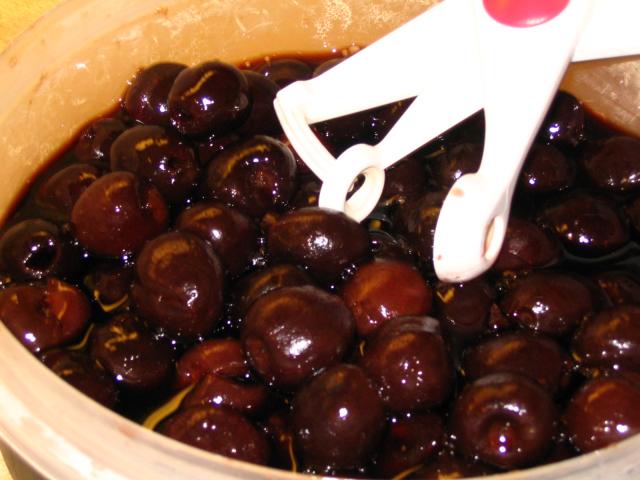
14. Mise-en-place for filling (pitted macerated cherries, sugar, kirsch, lemon juice, salt, flavorings, cornstarch slurry). Simmer everything except the butter and cornstarch slurry over medium-low heat, covered, for about 25 minutes. Taste to make sure the flavor is just tart/sweet enough. You can add sugar and lemon, but not take them out. Stir in the slurry and bring to a full boil, stirring constantly. The mixture will be a little soupy, as it will set up when cool. You do not want a stiff, cherry-jam filling!
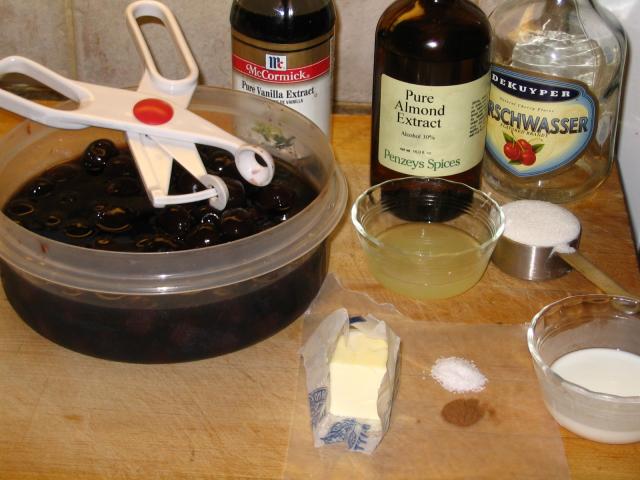
15. Off heat, stir in the diced butter. This gives the filling a good sheen and mouth feel, as well as a good flavor. Let cool at least to room temp (you can chill overnight).
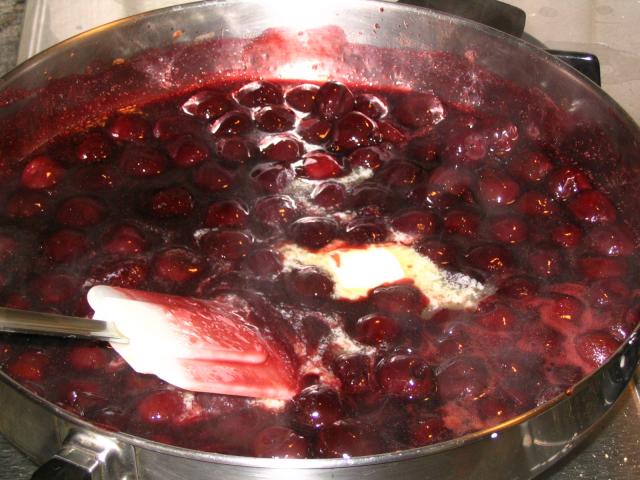
16. Cooled filling into prepped pan

17. Partly covered pie with streusel
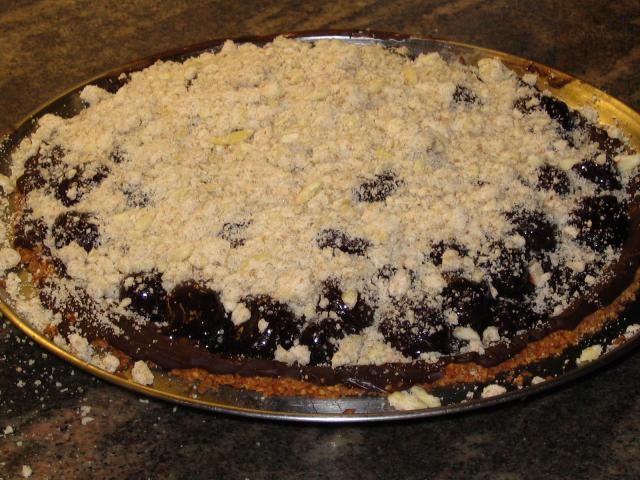
18. Finished unbaked pie chilled, ready for oven
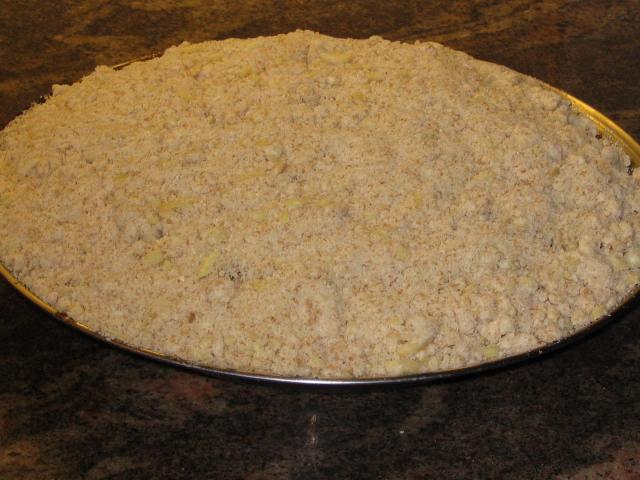
19. Finished, baked whole pie
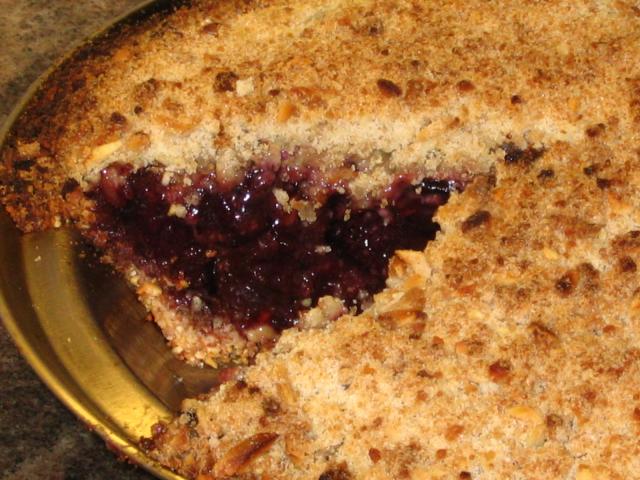
20. Plated slice
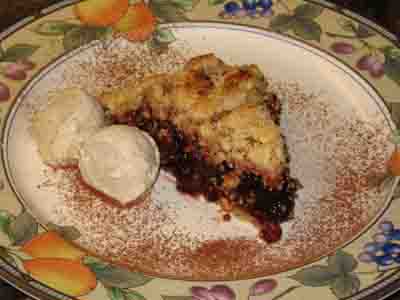
-
Have you broken down many recipes and done calorie comparisions JayBassin? How does a graham cracker crust compare to a nut crust calorie wise?
I don't think calorie comparisons work because calories don't reflect the type of fat. For example, most (all?) commercial graham crackers contain trans fats, which are seriously bad news. Nuts have more grams of fat than graham crackers, but depending on the nut (avoid macademia), the fat is monounsaturated and may actually be good for you (in small doses).
You can reduce calories from sugar by using splenda instead of sugar, but after all, it is a dessert!
BTW, Wendy, I really like your p/b forum and look forward to participating in the pie demos.



tonkatsu
in Japan: Cooking & Baking
Posted
I mix half ketchup and half home-made tare marinade (which I keep on hand for teriyaki). That way, I don't end up with lots of different specialty sauces in the fridge.